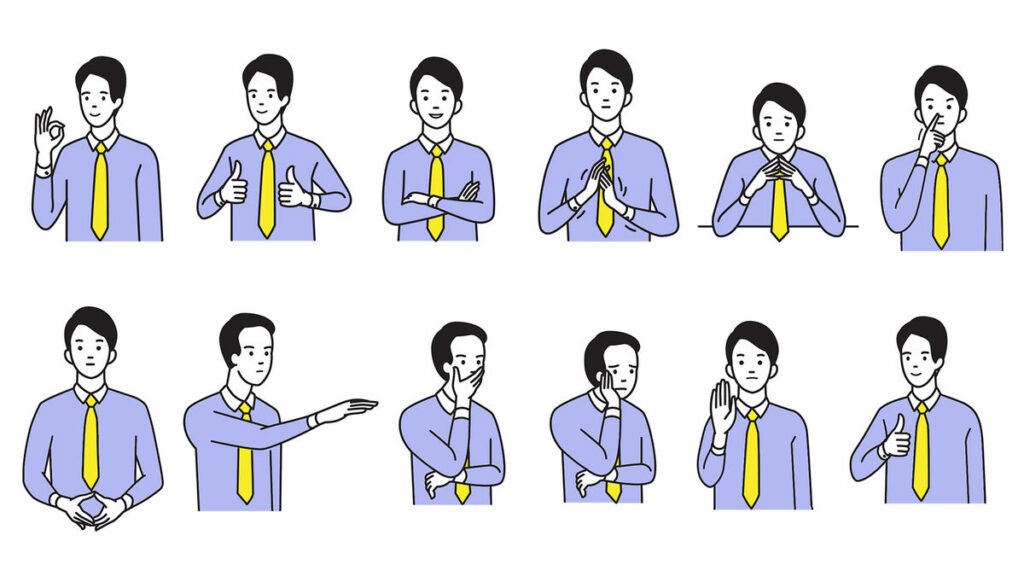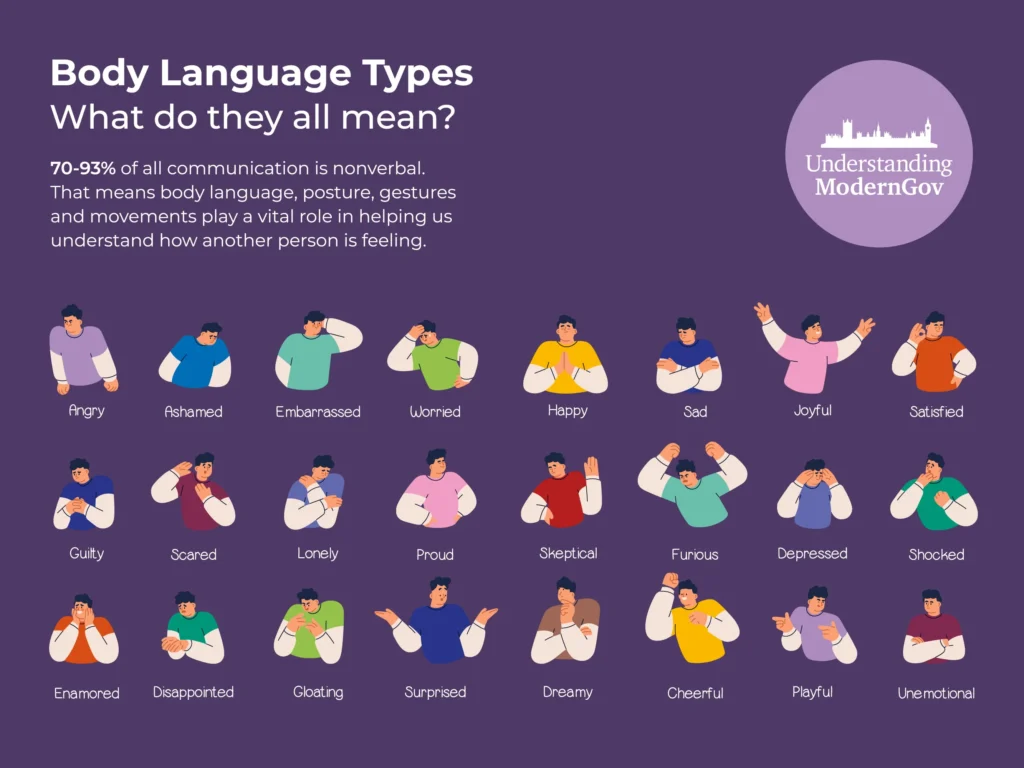Introduction:
Words are merely the melody in the complex symphony of human contact; the real depth is found in the nonverbal dance of body language. This ]article delves into the subtleties of Kinesics in Communication, revealing its enormous influence on our day-to-day interactions. Beyond language, gender, and cultural barriers, body language enhances our knowledge of one another through the silent power dynamics ingrained in posture and the unsaid eloquence of facial expressions.
Changing Body Language for Cross-Cultural Communication:
Contents
- 1 Changing Body Language for Cross-Cultural Communication:
- 2 Disguise Body Language: Revealing Hidden Motives:
- 3 Gender’s Effect on Nonverbal Communication
- 4 Mirroring: Forming a Relationship by Copying: Kinesics in Communication
- 5 Power Dynamics: Leadership Body Language:
- 6 Proxemics as a Tool for Understanding Personal Space
- 7 Taking on Confidence: The Impact of Power Pose
- 8 The Effects of Stress on Body Language: >>Kinesics in Communication
- 9 Microaggressions: Inconspicuous Nonverbal Cues and Their Repercussions:
- 10 The Use of Intuition in Body Language Interpretation:
- 11 The Relationship Between Personal Branding and Body Language:
- 12 Relationship Mirroring: Establishing Connection and Trust:
- 13 Tactile Communication: The Power of Touch:
- 14 Nonverbal Communication in Public Speaking:
- 15 The Art of Apologizing in Kinesics in Communication:
- 16 The Development of Body Language Throughout Human History:
- 17 Methods for Teaching and Learning Body Language:
- 18 Body Language in Negotiations:
- 19 Nonverbal Communication in Customer Service:
- 20 Combining Nonverbal and Verbal Communication to Increase Impact:
- 21 Conclusion
- 22 FAQs:
- 22.1 For what reason does body language matter in communication?
- 22.2 Is Kinesics in Communication universally understood, or does it differ depending on the culture?
- 22.3 What are some ways to get better at reading body language?
- 22.4 Exist any situations where body language might be misconstrued or misleading?
- 22.5 What effects does technology have on body language interpretation, particularly when communicating virtually?
- 22.6 Is it Possible to Fake Body Language, and How Can One Recognize Inauthentic Signals?
- 22.7 What Effects Does Technology Have on Nonverbal Communication, Particularly in Online Conversations?
- 22.8 What Are Some Common Body Language Indicators That Cut Across Cultural Boundaries?
Understanding how cultural norms affect nonverbal clues is essential for cross-cultural communication. This section looks at how, in cross-cultural situations, body language adaptation can promote understanding and avoid miscommunication. >>>Kinesics in Communication
Disguise Body Language: Revealing Hidden Motives:
This section explores signs of dishonesty, delving into the world of deception. Readers receive knowledge about identifying clues of dishonesty and comprehending the underlying intentions through body language and microexpressions. >>>Kinesics in Communication
Gender’s Effect on Nonverbal Communication
The nonverbal ways in which people express themselves are greatly influenced by their gender. This section examines the biological factors, cultural variances, and societal expectations that determine gender-specific body language.

Mirroring: Forming a Relationship by Copying: Kinesics in Communication
Mirroring is the practice of gently mimicking another character’s nonverbal cues to set up a rapport. This section examines the psychology of mirroring, the way it helps establish rapport and the way people can deliberately use it in different types of encounters.
Power Dynamics: Leadership Body Language:
Nonverbal clues frequently serve as leadership indicators. This section looks at how leaders affect team dynamics and organizational culture by using body language to project authority, confidence, and approachability. >>Kinesics in Communication
Proxemics as a Tool for Understanding Personal Space
Proxemics is the study of how people communicate using their personal space. This section examines how relationships and interactions are impacted by how various cultures and individuals understand and value personal space.
Taking on Confidence: The Impact of Power Pose
Adopting extensive stances to exude self-belief is referred to as an energy pose. This phase looks at the psychology of energy poses, their science, and the way humans can make use of them to reinforce self-belief.
The Effects of Stress on Body Language: >>Kinesics in Communication
Stress can display itself in frame language in quite a few ways. This section explores the approaches in which strain affects posture, facial expressions, and gestures, providing steerage on figuring out and dealing with pressure in oneself and others.
Microaggressions: Inconspicuous Nonverbal Cues and Their Repercussions:
Subtle nonverbal clues are regularly used to talk about microaggressions. This segment ambitions to elevate awareness and know-how with the aid of examining the consequences of microaggressions on relationships, conversation, and popular well-being. >>>Kinesics in Communication

The Use of Intuition in Body Language Interpretation:
Nonverbal cues are largely decipherable with the use of intuition. This section examines the relationship between body language and intuition, highlighting the value of following one’s gut when communicating.
The Relationship Between Personal Branding and Body Language:
Personal branding is not limited to spoken words. This section looks at how people can support authenticity and consistency in professional settings by matching their body language to their brand.
Relationship Mirroring: Establishing Connection and Trust:
Mirroring is an effective strategy for developing trust and connection in relationships that extend beyond first impressions. This section explores the role that mirroring plays in intimacy and relationship dynamics.
Tactile Communication: The Power of Touch:
Nonverbal verbal exchange can be effectively conveyed through contact. The cultural, emotional, and psychological ramifications of tactile conversation are tested in this segment, with a focal point on the feature of contact in bonding and expressing affection.
Nonverbal Communication in Public Speaking:
Speaking in public efficaciously calls for more than simply phrases. This phase covers how powerful nonverbal verbal exchange, consisting of vocal modulation and body language, can enhance the effectiveness of public talks.>>Kinesics in Communication
The Art of Apologizing in Kinesics in Communication:
Nonverbal Components of Expressing Remorse: Apologies go beyond words. This section looks at body language indicators that express regret and resolve to make changes to better understand the nonverbal aspects of genuine apologies.
The Development of Body Language Throughout Human History:
Body language has changed over time. This section explores how body language has changed historically, from ancient civilizations to the current period, and how these changes are influenced by cultural and societal trends. >>>Kinesics in Communication
Methods for Teaching and Learning Body Language:
Education is a key factor in improving body language awareness. This section looks at interactive exercises and practical applications that are useful for teaching and understanding body language.
Body Language in Negotiations:
Nonverbal clues dance in the course of negotiations. This phase explores the position that frame language understanding performs in hit negotiations, looking at numerous techniques to communicate energy, adaptability, and cooperation.
Nonverbal Communication in Customer Service:
Nonverbal communique has the strength to steer how clients feel about an organisation. This phase appears at how frame language influences interactions, loyalty, and customer satisfaction.
Combining Nonverbal and Verbal Communication to Increase Impact:
When nonverbal and verbal communication work together, the overall impact is increased. This section offers advice on how to successfully blend these two components to produce a pleasing and captivating communication style.

Conclusion
We explore the various terrains of nonverbal communication, observing the flexibility needed in cross-cultural interactions and revealing the hidden motives concealed by misleading cues. It becomes clear how power relations work, and the deft use of mirroring creates connections. Our personal space is defined by proxemics, our confidence is shaped by power postures, and the subtle reverberations of stress are conveyed through our movements.
In partnerships, body language becomes the unsaid poetry that unites people, whether it is reflected in trust or communicated through touch. Both on stage and at the negotiating table, the combination of expressive speech and graceful body language creates memorable stories and ensures effective outcomes.
This investigation explores the complex evolution of Kinesics in Communication, weaving it into the evolutionary history of humans. It goes beyond academia by providing useful methods for imparting and learning this silent language, whose proficiency is crucial for interacting with customers, improving experiences, and fostering loyalty.
Ultimately, the synthesis of verbal and nonverbal cues becomes the pinnacle of successful communication. May we be aware of the melodic exchange between words and gestures as we go through this silent dance, understanding that the unsaid is the common language that unites all people.
FAQs:
For what reason does body language matter in communication?
In response, frame language is a critical part of verbal exchange since it makes use of nonverbal cues to specific attitudes, intentions, and feelings. Gaining the know-how of the ability to read frame language improves communique with the aid of selling empathy, growing belief, and forging greater authentic connections.
Is Kinesics in Communication universally understood, or does it differ depending on the culture?
Answer: Cultural differences are a major factor in body language, even if certain components may be universally understood. Mouth movements and expressions While posture and other factors might differ greatly, cultural sensitivity is crucial for precise interpretation and successful cross-cultural communication.
What are some ways to get better at reading body language?
To beautify one’s capability to decipher body language, one must interact in energetic observation, practice, and focus-constructing. Practice identifying and deciphering nonverbal signs and symptoms, including gestures or microexpressions, will help you turn out to be extra proficient through the years.
Exist any situations where body language might be misconstrued or misleading?
Answer: Body language can be misconstrued or deceptive in certain situations. Misunderstandings may arise from a variety of factors, including context, cultural variances, and individual differences. For a more correct interpretation, it is necessary to take into account certain indications as well as the larger context.
What effects does technology have on body language interpretation, particularly when communicating virtually?
In response, technology brings with it both new possibilities and obstacles for reading body language in virtual communication. Although video conversations offer some visual signals, there are restrictions. People must adjust and improve their digital communication abilities as emojis, GIFs, and other digital expressions become indispensable for communicating nonverbal cues.
Is it Possible to Fake Body Language, and How Can One Recognize Inauthentic Signals?
Although it is possible to intentionally control body language, nonverbal clues can reveal sincerity. Forced grins, erratic movements, or discrepancies between spoken and nonverbal cues are examples of inauthentic signals. Understanding each person’s baseline habits and using acute observation is typically necessary to identify these variances.
What Effects Does Technology Have on Nonverbal Communication, Particularly in Online Conversations?
Technology has modified the manner humans communicate, bringing with it both new difficulties and probabilities for nonverbal expression. Emojis, video conferencing, and different virtual cues increase the use of facial expressions, gestures, and eye contact in digital interactions. In the ever-evolving world of technology, being able to examine the subtleties of digital frame language turns into important for green communication.
What Are Some Common Body Language Indicators That Cut Across Cultural Boundaries?
Certain body language indicators are universally understood, despite cultural differences. For instance, a sincere grin, direct eye contact, and an open body position frequently communicate good intentions to people from other cultures. Investigating these common indicators promotes cross-cultural knowledge and assists people in navigating a variety of environments.












